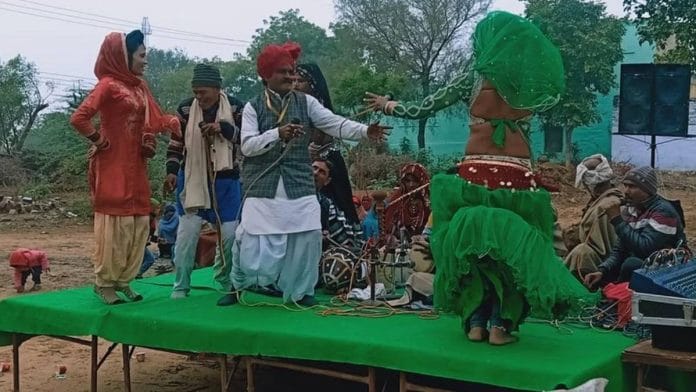Gurugram: The Haryana government has invited applications for the Dhanpat Singh Saangi Memorial Award, dedicated to recognising and honouring artistes who perform the state’s traditional saang art form. The award includes a cash prize of Rs 1 lakh, a citation and a shawl. Artistes looking to be considered have been asked to submit their applications to the Directorate of Information, Public Relations & Languages by 6 January.
The announcement has brought renewed attention to saang, a folk theatre that blends music, storytelling and dance, represents the cultural ethos of the region and remains a symbol of its artistic legacy. “The government’s motive behind launching this award is to preserve and promote Haryana’s cultural heritage,” said Ranbir Sangwan, additional director in the Directorate of Information, Public Relations & Languages.
Those who send their entries will be invited to perform in the Saang Mahotsava to be organised later this year.
Last year, the award was given to saang artist Ved Prakash Atri for his performance in the Saang Mahotsava held in Kurukshetra. A special review committee consisting of researchers, professors, and distinguished personalities selects the winner, said Sangwan.
Dhanpat Singh, also referred to as Rai Dhanpat Singh, was a popular saang artist from Rohtak’s Nindana village—also the native place of former CM Manohar Lal Khattar.
Singh was born in 1912 and died on 29 January, 1979. Khattar, who had watched Singh perform during his childhood, initiated an award in his name in 2022.
Also Read: Haryanvi songs are moving from vulgarity to veil — ghoonghat is sexualised, male gaze the muse
All about ‘saang’
Saang is a traditional folk theatre form originating from Haryana and nearby regions, including Rajasthan and Uttar Pradesh. Known for its dynamic blend of storytelling, music, and dance, it has been a key medium of entertainment and cultural expression in rural Haryana for centuries. Saang narrates stories that are often drawn from Indian epics like the Ramayana and Mahabharata, folklore or local legends.
The stories typically convey moral or social lessons.
Songs accompanied by traditional instruments like the dholak, nagada and harmonium form an integral part of saang performances and are used to heighten the emotional impact of the story being conveyed. Saang also incorporates witty dialogues and satirical elements to engage the audience, often addressing societal issues in an entertaining manner.
Historically, men played all roles, including female characters. Over time, however, women have also started participating in the art form. Performances usually take place in open spaces such as village squares, fairs, or festival gatherings.
The origins of saang can be traced back several centuries. Some scholars suggest that the art form evolved during the medieval period as a way to educate and entertain the masses in rural areas.
One of the most celebrated figures of the art form is poet Lakhmi Chand (1903–1945), who is also referred to as the ‘Kalidasa of Haryana’. His works gave saang a distinct identity and elevated its status in regional folklore.
Rajbir Deswal, a retired police officer and author of the book Wit and Humour of Haryana, told ThePrint that saang has traditionally been an oral art form, passed down through generations without a written script.
“Saang draws its content from religion, legends, historical events, notable personalities and local heroes,” Deswal explained. “Care was always taken to ensure that saang did not venture into nudity or obscenity. However, women and children were often kept away from performances as they sometimes escalated into disputes and quarrels.”
He emphasised that music plays a central role in saang performances, with tunes designed to be loud and audible from a distance. Much of the content is inspired by qissas or narratives from mythology and folklore.
Popular themes include the stories of Shiv-Parvati, Lord Vishnu and other mythological figures, which were frequently adapted into saang performances.
Dr Haneef Bhatti, a drama educator at the Board of School Education in Bhiwani, who earned his doctorate with a thesis titled ‘Haryana Aur Punjab Ke Lok Rangmanch’ (folk theatres of Punjab and Haryana), told ThePrint that saang, also known as swang, literally translates to “vesh dharan” or “roop dharna”, meaning “to impersonate” or “to assume a form”.
“Saang is believed to have originated over 300 years ago, around 1700 CE, in undivided Punjab, which included parts of present-day Rajasthan and western Uttar Pradesh,” he added.
Mix of ‘bhaand’ & ‘mujra’
Before the advent of saang, bhaand (clumsy stand-up comedy) and mujra (a form of dance performed by women) were the primary sources of entertainment.
Bhaand performances, known for their humour and slapstick comedy, were enjoyed by the common folk, while mujra, an expensive affair, was reserved for the elite during their social gatherings. Over 250 years ago, saangi Krishan Lal Bhaat combined the elements of comedy, mujra and singing to create the new genre of saang.
To address the high costs associated with hiring female mujra dancers, he innovatively had men dress up as women to perform female roles in saang. What started as a cost-saving measure became a tradition, and to this day, male actors continue to play the roles of female characters in saang performances.
Over time, saang artistes have continually evolved the art form, adding fresh innovations and creative elements, ensuring its enduring appeal and cultural relevance.
Bhatti also spoke of some prominent saang artistes and their notable themes. Notable saangis from Haryana include Master Nekiram, Mange Brahman, Baje Nai, Dada Lakhmi Chand and Chander Badi.
Each artiste added a unique flavour to the art form, ensuring saang’s enduring legacy, he said.
(Edited by Nida Fatima Siddiqui)
Also Read: Myths, men in ghagras, storytelling — there’s a push to revive Saang, Haryana’s answer to Nautanki






